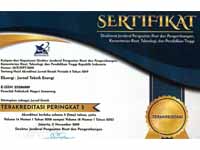Solar Cell Performance Test against Load Variations
DOI:
https://doi.org/10.32497/eksergi.v18i2.3570Keywords:
solar cell, intensity, electrical current, radiationAbstract
Solar cell is a converter of light energy into electrical energy. This study aims to examine the characteristics of the solar cell to load variations. The research was conducted at the Semarang State Polytechnic Energy Conversion Lab. The solar cell used in the research of the monocrystalline solar cell type KTENG CP-520S. The research method is carried out by measuring the value of solar intensity, voltage and electric current from the solar cell, then calculating the value of the power and efficiency of the solar cell. The greater the intensity of sunlight, the better the characteristics of the solar cell with a note that the solar cell surface temperature must be stable at 250C. The results showed that the highest input power of the solar cell was 5293.69 watts at a lamp load of 115 watts at 833.6 W/m2 of radiation during sunny weather. The highest value of the output power of the solar cell is 191.52 watts when the lamp is loaded with 190 watts of radiation at 739.4 W/m2 during sunny weather. While the highest value of the load output power is 212.43 watts when the lamp is loaded with 200 watts of radiation at 724.4 W/m2 when the weather is sunny. The highest efficiency of the solar cell is 4.13% when the lamp is loaded with 200 watts of radiation at 724.4 W/m2 when the weather is sunny. And the highest value of Solar Power Plant efficiency is 4.61% at a 200 watt lamp loading at 724.4 W/m2 radiation when the weather is sunny.References
Amanda Guntur, Perbandingan Penggunaan Motor DC dengan Motor
AC Sebagai Penggerak Pompa Air yang Disuplai Oleh Sistem
Pembangkit Listrik Tenaga Surya (PLTS), Sumatera Utara:
Universitas Muhammadiyah Sumatera Utara.
Afifudin, Faslucky, Farid Samsu Hananto, ” Optimalisasi Tegangan
Keluaran Dari Solar Cell Menggunakan Lensa Pemfokus Cahaya
Matahari”, Jurnal Neutrino, Vol.4, No. 2.
Arismunandar, Wiranto, Teknologi Rekayasa Surya, Cetakan
Pertama, Jakarta : PT. Pradnya Paramita, 1995.
Arya Mertasana Putu, Pengaruh Kebersihan Modul Surya Terhadap
Daya Output yang Dihasilkan pada PLTS Kayubihi Kabupaten
Bangli. Bali : Universitas Udayana, 2017.
Darsono, Pompa dengan Energi Potensial. Surakarta : Universitas
Muhammadiyah Surakarta, 2012
Hasan, Zainul, Erika Rani, “Rancang Bangun Konversi Energi Surya
Menjadi Energi Listrik Dengan Model Elevated Solar Tower” Jurnal
Neutrino, Vol.4, No. 2, 2012.
I.W.G.A Anggara, I.N.S Kumara, “Studi Terhadap Unjuk Kerja
Pembangkit Listrik Tenaga Surya 1920 Watt Di Universitas Udayana
Bukit Jimbaran”, E-Journal Spektrum Vol.1 No.1, 2014
Kementerian Energi dan Sumber Daya Mineral, Panduan Perencanaan
dan Pemanfaatan PLTS atap di Indonesia, 2020.
Khurmi R.S. dan Gupta J.K, A Textbook of Machine Design (S.I
Unit), Eurasia Publishing House (PVD). LTD., First Multicolour
Edition, New Delhi, 2005.
Septiana, Wilman, dkk, “Laporan Akhir Penelitian Bidang Energi
Penghargaan Pt. Rekayasa Industri”, Bandung : Institut Teknologi
Bandung, 2007.
Sianipar, Rafael, “Dasar Perencanaan Pembangkit Listrik Tenaga
Surya”, Jurnal. Jakarta : Universitas Trisakti, 2014.
Sukendar, Proyek Pengenalan Program Energi Baru Terbarukan Pada
Sekolah Menengah Kejuruan Di Indonesia Pembangkit Listrik
Tenaga Surya (PLTS), Edisi 1, Bandung: Pusat Pengembangan Dan
Pemberdayaan Pendidik Dan Tenaga Kependidikan (PPPPTK)
Bidang Mesin dan Teknik Industri, 2008.
Trends in Photovoltaic Application, survey report of selected IEA
countries between 1992 and 2009, Report IEA-PVPS T1- 19:2010.
Persyaratan Umum Instalasi Listrik 2011, 2011.
Victor Shah Arvind. Thin-Film Silicon Solar Cells. Switzerland :
EPFL Press, 2010.
Downloads
Published
Issue
Section
License
Authors who publish with this journal agree to the following terms:Authors retain copyright and grant the journal right of first publication with the work simultaneously licensed under a Creative Commons Attribution License that allows others to share the work with an acknowledgement of the work's authorship and initial publication in this journal.
Authors are able to enter into separate, additional contractual arrangements for the non-exclusive distribution of the journal's published version of the work (e.g., post it to an institutional repository or publish it in a book), with an acknowledgement of its initial publication in this journal.
Authors are permitted and encouraged to post their work online (e.g., in institutional repositories or on their website) prior to and during the submission process, as it can lead to productive exchanges, as well as earlier and greater citation of published work (See The Effect of Open Access).






